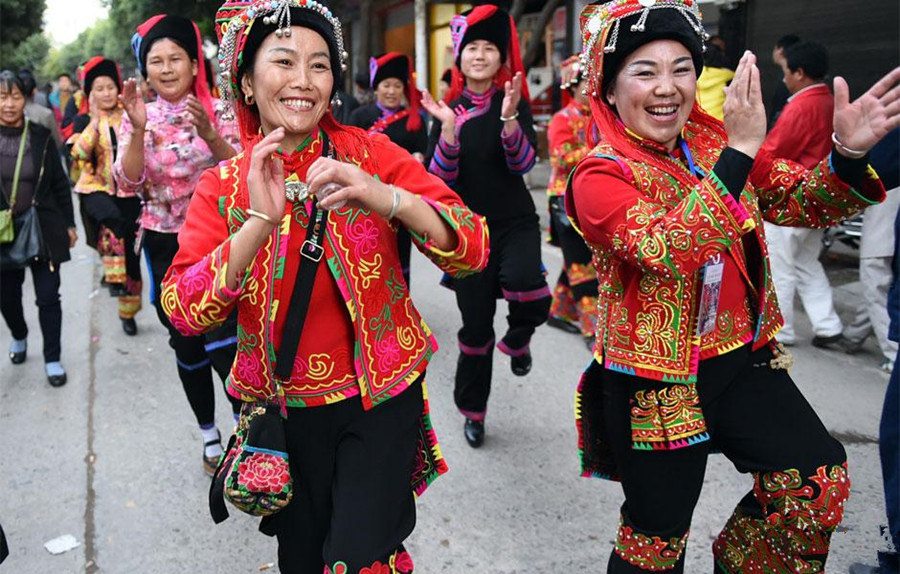 alt="Puer Surrounding Counties and Towns: Weekly & Special Local Markets Travel Guide"
/>
alt="Puer Surrounding Counties and Towns: Weekly & Special Local Markets Travel Guide"
/>
People and Population in Honghe
Honghe Hani and Yi Autonomous Prefecture, located in southeastern Yunnan Province, China, is home to a diverse population comprising various ethnic groups. Here’s an overview of the people and population in Honghe:
Honghe People and Ethnic Diversity: Honghe Prefecture is characterized by its ethnic diversity, with several ethnic minorities coexisting alongside the Han Chinese majority.
Ethnic Minorities in Honghe:
- Hani (哈尼族): The Hani people are one of the major ethnic groups in Honghe. They have a distinct culture, language (Hani language), and traditions, including their unique terraced agriculture practices.
- Yi (彝族): The Yi people also form a significant ethnic minority in Honghe. They have their own language and cultural practices, contributing to the region’s cultural tapestry.
- Han Chinese (汉族): Han Chinese are the largest ethnic group in China and are also present in Honghe Prefecture, engaging in various economic activities and administrative roles.
- Other Ethnic Minorities: Smaller ethnic groups such as the Miao (苗族), Zhuang (壮族), Yao (瑶族), and others are also found in Honghe, each with their own cultural identities and traditions.
Number of Ethnic People and Han People:
- Specific population figures for each ethnic group in Honghe can vary and are documented in local census reports or official publications. These figures reflect the demographic composition influenced by historical settlement patterns and migration.
People’s Life in Honghe:
- Lifestyle: Life in Honghe revolves around agriculture, with terraced rice fields being a prominent feature of the landscape. The Hani and Yi people traditionally practice agriculture, with rice, tea, and other crops being cultivated.
- Culture: Honghe hosts various cultural festivals and events that highlight the traditions and customs of its diverse ethnic groups. These include traditional dances, music, handicrafts, and culinary traditions.

Economic Activities:
- Economy: Agriculture remains the primary economic activity in Honghe, with the cultivation of rice, tea, tobacco, and other crops being significant. The region’s natural resources and cultural heritage also support tourism as an emerging industry.
Population Data of Honghe Hani and Yi Autonomous Prefecture
- As of the End of 2019:
- Permanent population: 4.775 million, an increase of 31,000 from the previous year.
- Urbanization rate of the permanent population: 49.09%.
- Birth rate: 11.27‰.
- Death rate: 6.1‰.
- Natural growth rate: 5.17‰.
- As of November 1, 2020 (Seventh National Census):
- Permanent population: 4,478,422.
- As of the End of 2022:
- Permanent population: 4.405 million, a decrease of 31,000 from the previous year.
- Registered population: 4.7028 million, an increase of 5,279 from the previous year.
- As of the End of 2023:
- Permanent population: 4.363 million.
- Urbanization rate of the permanent population: 50.1%, an increase of 0.85 percentage points from the end of 2022.
- Urban permanent population: 2.1859 million, an increase of 16,400 from the end of 2022.
- Rural permanent population: 2.1771 million, a decrease of 58,400 from the end of 2022.
- Registered population: 4.7064 million, an increase of 3,587 from the end of the previous year.
For the most accurate and detailed information regarding the people and population of Honghe, consulting official demographic studies or local government sources would provide precise figures and insights into the region’s cultural richness and socio-economic dynamics.

 7 Days GolfingTour
7 Days GolfingTour
 8 Days Group Tour
8 Days Group Tour
 8 Days Yunnan Tour
8 Days Yunnan Tour
 7 Days Shangri La Hiking
7 Days Shangri La Hiking
 11 Days Yunnan Tour
11 Days Yunnan Tour
 6 Days Yuanyang Terraces
6 Days Yuanyang Terraces
 11 Days Yunnan Tour
11 Days Yunnan Tour
 8 Days South Yunnan
8 Days South Yunnan
 7 Days Tea Tour
7 Days Tea Tour
 8 Days Muslim Tour
8 Days Muslim Tour
 12 Days Self-Driving
12 Days Self-Driving
 4 Days Haba Climbing
4 Days Haba Climbing
 Tiger Leaping Gorge
Tiger Leaping Gorge
 Stone Forest
Stone Forest
 Yunnan-Tibet
Yunnan-Tibet
 Hani Rice Terraces
Hani Rice Terraces
 Kunming
Kunming
 Lijiang
Lijiang
 Shangri-la
Shangri-la
 Dali
Dali
 XishuangBanna
XishuangBanna
 Honghe
Honghe
 Kunming
Kunming
 Lijiang
Lijiang
 Shangri-la
Shangri-la
 Yuanyang Rice Terraces
Yuanyang Rice Terraces
 Nujiang
Nujiang
 XishuangBanna
XishuangBanna
 Spring City Golf
Spring City Golf
 Snow Mountain Golf
Snow Mountain Golf
 Stone Mountain Golf
Stone Mountain Golf












 What Our Customers Say?
What Our Customers Say?
